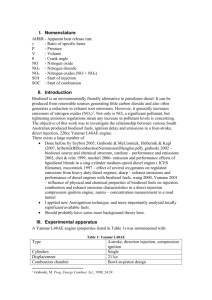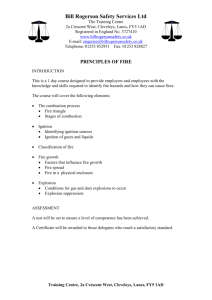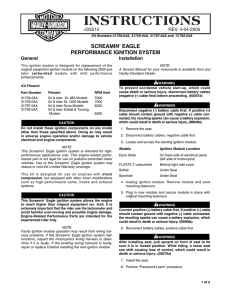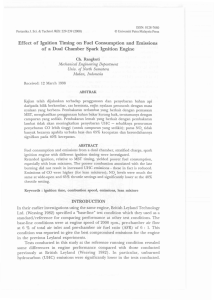Slide 1
advertisement
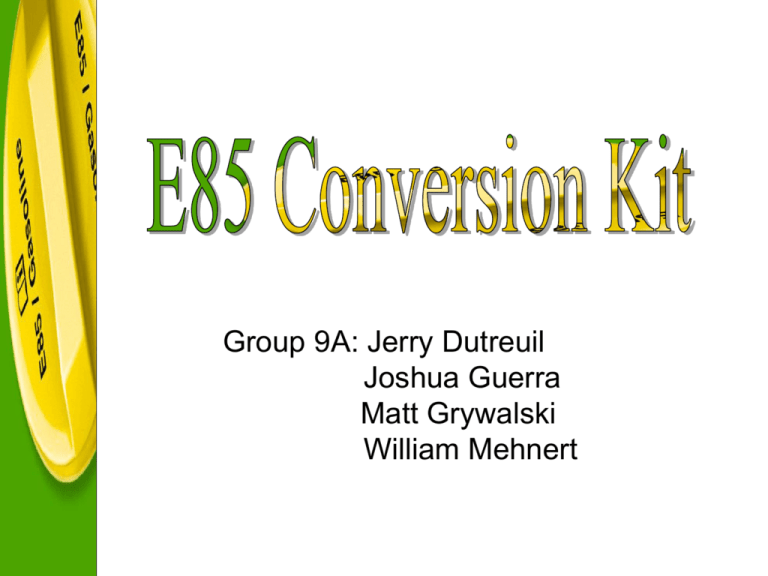
Group 9A: Jerry Dutreuil Joshua Guerra Matt Grywalski William Mehnert Overview • • • • • • • Project Objectives Conceptual Design Q&A for Presentation 1 Technical Analysis Plan for Phase 3 Nugget Chart Conclusion Project Objective • Convert a gasoline engine to operate on E85 without sacrificing fuel consumption, increasing performance and reducing emissions • Provide a control system unit to manage the engine Conceptual Design FFS ECM Injectors Ignition Exhaust Gases O2 EGT Fuel Q&A Presentation 1 • Engine Cooling – No change to combustion chamber temperatures • Materials – Engines have been manufactured to run on ethanol (E10) for over a decade Areas for Technical Analysis • Ignition Timing • Explosion Limits • Emissions • Power/Torque Ignition Timing • Used to control power and chamber temperatures • Typical Ignition timing ranges from 5˚BTDC at start to over 40˚BTDC at higher RPMs • Temperatures and power will be measured before and after the conversion to optimize timing Ignition Timing Explosion Limits • Equations: – LEL =( P1 + P2 + ... Pn)/(P1/lel1 +P2/lel2 + ... Pn/leln) – UEL =( P1 + P2 + ... Pn)/(P1/uel1 +P2/uel2 + ... Pn/ueln) Fuel Gasoline Ethanol Lower Limit 1.4 3.3 Upper Limit 7.6 19 Explosion Limits • LEL=1/[(.15/1.4)+(.85/3.3)]=2.74 • UEL=1/[(.15/7.6)+(.85/19)]=15.5 • Lambda – Measures fuel content in combustion chamber (AFR/AFRstoich) – Typical range between .68 and 1.4 – Corresponding values based on explosion limits are .56 to 3.65 • Fuel will combust Emissions • Although emissions can be theoretically calculated the process is extremely involved • Emissions will be measured prior to conversion and after (without the use of a catalytic converter) based on EPA standards Emissions • Local Testing Procedure (IM240) – 240 Seconds Test – Average Speed 30 MPH – Max Speed 56.7 MPH – Total of 2 Miles – Idle time to be less than 3.8% of total time Power/Torque • Power Calculated from measured Torque – HP =(Torque x rpm)/5250 • Torque optimized by changing timing • Baseline and final torque will be measured on a chassis dynamometer Power/Torque Sample affects of ignition timing Ignition Timing (Degree) Temperature (K) Work (J) Exerted Pressure (kPa) 0° 2500 20 3600 -5° 2550 21 4275 -10° 2600 22 5700 +5° 2450 18 3075 **Based on applet designed by Colorado State, http://www.engr.colostate.edu/~allan/thermo/page6/EngineParm2/Engine.html Timing adjusted, all other values held constant Plan for Phase 3 • Prototype – Ignition timing model – Fuel consumption model • Plan – Fit ECM to engine with existing sensors – Test engine operation prior to conversion • Purchase – – – – Engine ECM Various Sensors Dynamometer time Nugget Chart Conclusion • With ignition timing, we will control the combustion in the cylinder chamber • We will provide a kit that will enable someone to run on E85/gasoline blend Thank you • Any Questions? Reference • • • • • • • • • www.change2E85.com www.megasquirt.info www.flextek.com www.e85fuel.com www.eere.energy.gov www.diablosport.com www.e85vehicles.com www.e85prices.com www.aa1car.com • • • • http://www.eng-tips.com/viewthread.cfm?qid=33615 http://www.engineeringtoolbox.com/explosive-concentration-limits-d_423.html http://www.allpar.com/fix/EPAMethods.html http://www.techedge.com.au/vehicle/wbo2/wblambda.htm • Effect of Advanced injection timing on emission characteristics of diesel engine running on natural gas Effect of Ethanol-gasoline blends on engine performance and exhaust emissions in different compression ratio The effects of ethanol-unleaded gasoline blends and ignition timing on engine performance and exhaust emissions • • Chemical Equilibrium • Gasoline – C8H18+12.5(O2+3.76N2) CO2+3H2O+12.5(3.76N2) • Ethanol – C2H5OH+3(O2+3.76N2) 2CO2+3H2O+3(3.76N2) Formulas Used




